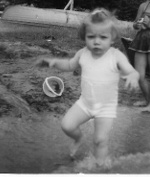I was given the gift of the love of swimming by my mother who brought me to the YMCA as a child. I have never been afraid of the water. Lake and ocean views fill me with great peace. I enjoy sailing and kayaking, have “snuba-dived” deep below the Caribbean ocean, and snorkelled in coves filled with exotic and dangerous creatures. I was pulled under and then tossed violently onto the beach by a rogue wave while body surfing in Maui. I go back for more, because I love the water.
Part of my confidence has come from my great ability to hold my breath, a skill I developed due to my fear of breathing while doing front crawl. I marvel at how strong, serious swimmers repeatedly slice precisely through the water, face down, then seamlessly turn their heads to the side for a precious breath of air. I am very comfortable with swimming on my back, side, and “dog paddle” with my head above water. When it came to front crawl I simply learned to hold my breath for longer periods, then paused to tread water, take a breath, then continued swimming… four pairs of strokes, then eight, and ten, without one breath. Once an astonished physician advised me after a lung capacity test that my lungs were at least 20% greater capacity than any of the staff or patients in his clinic. I told him about my swimming experiences and noted “I always thought I would like to be a pearl diver.” He responded “You could definitely be a pearl diver.”
I had tried all my life to swim front crawl with breath intervals, without success, until today. I made it a mission this summer to conquer my fear. I had been back at the “Y”, doing lengths with my usual one breath to cross the pool. Suddenly it struck me that maybe I had been doing it all wrong. I had been afraid to risk slightly raising my face to the side above the water while moving; I felt uncoordinated about at which point I should take the breath, how far to turn my head, I worried about inhaling water, and not being in control. So instead of focusing on getting quickly across the pool, I experimented with how many strokes I should take before taking a breath, taking the measured and steady approach. I discovered that if I planned ahead and slowly took a breath to the left between my third and fourth stroke, then concentrated on completing the fourth stroke, I could do it. Instead of one breath to cross the pool, I was now doing it in three or four, with increasing confidence, speed and energy.
Conquering a personal fear is very empowering. By taking the time to break my inhibitions down into manageable pieces and experimenting with alterate methods, I liberated myself. I had always worried that if I was ever stuck for a long time in open water that I would not be able to swim to shore. I am gaining confidence that with practice I can become a strong swimmer now.
There have been many news reports this summer of children drowning. In some cases they are from immigrant families who did not have the opportunity to learn to swim in their homeland. The YMCA is a tremendous not-for-profit organization with very reasonable monthly fees, some geared to those with limited income. They offer family rates, and a lot of pool time and lessons. At my “Y” I learned that there is an adult swim class for all levels, taught by someone who trains Olymic athletes. Children as young as three can take swimming lessons. Infants as young as three months of age have come to the pools, under the responsibility of their parents. Please give your child, or yourself, the gift of the love of swimming.
For more information see www.ymca.ca .
c. 2010 G. MacDonald


Today, as I was driving into the city, I listened to an interview with Henry Winkler on CBC. He talked about what he believes are the two cornerstones of a good life: gratitude and tenacity. You have demonstrated both with your article. I might add a third, the willingness to take manageable risks in order to move forward. Kudos to you and I hope to read many more. Luv AJ
Wonderful! I too have fond memories of those swimming lessons we got to go to after school. I wasn’t great at the breathing for the front crawl either; I connected with your description of conquering that fear. I took a stroke improvement class as an adult, and I was finally able to work that out. It didn’t help that as a kid my best friend’s mom was a swim instructor, and my best friend had reached Lifesaving certification and was doing swimathons. Your blog inspires me to confess that the stroke of which I was most fearful was the dolphin. Pin your legs together and do some flippy kick down all the while throwing your arms over your head, and dipping your head somewhere in there- are you kidding me? As an adolescent, I was too self-conscious to attempt that one, with the possibility that others in our neighbourhood might see me struggling to learn it. That discomfort caused me to quit swimming lessons just before the level where I’d be required to do that stroke. You have set the bar, my dear, perhaps it’s time for me to seek out a pool far from my neighbourhood and conquer that long-held aquatic fear too. Love the blog. R.